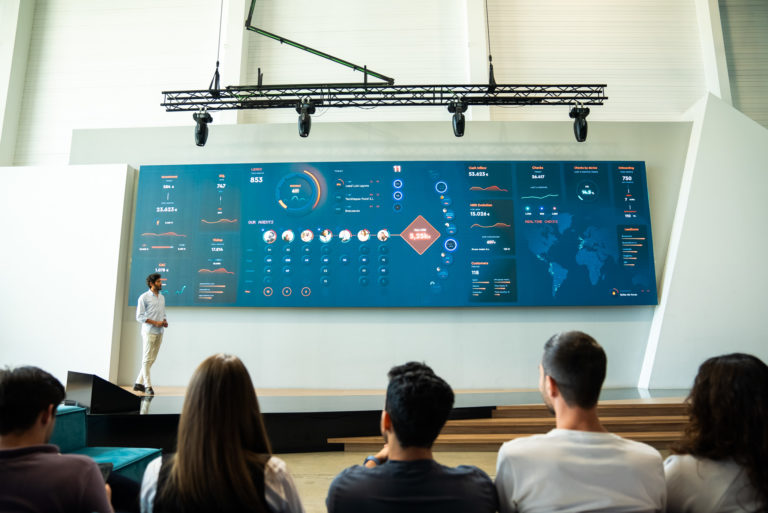Big data and Lego: building the data block by block

In a world where data flows non-stop, companies find themselves immersed in an ocean of information. Every click, every purchase, every move we make is a small piece of a very complex puzzle.
But how can we transform this sea of data into a tool to guide us in our business decisions? The answer lies in big data and data visualization to build stories with each piece of information. Together with big data and Lego, we will show you how to turn this maelstrom of data into valuable insights for your business.
The enigma of data: an analogy of Big Data with Lego pieces.
What is the relationship between Big Data and Lego? To give you an idea, Big Data is like a set of Lego blocks, where each piece of data is a single, seemingly insignificant piece, but when joined with others it allows you to build complex and meaningful structures.

Small facts that hide big trends
In this context, dashboards or command centers become the architect that organizes and shapes the pieces of Big Data. Imagine these dashboards as tools that allow us to visualize and analyze data in real time, giving the possibility to identify improvement trends.
It is essential that the data makes sense, that it helps companies to be more efficient, to improve day-to-day decisions and to optimize resources. The defined strategy must be supported by a clear understanding of what is really happening in each department. To do this, just as when we assemble a Lego we have a guide manual so that we know how to put the pieces in the right order and in the right place; a dashboard is the guide in companies to know where we are going and where we are going.
Data Bricks: optimization with the power of lego and big data
Imagine you are building the PAC-MAN Machine (any arcade game lovers out there?). You’re opening the bags of parts as instructed and, as you’re assembling it, you realize you’re missing several parts. You can’t continue with the construction until you get those pieces.
The same thing happens with the data. If it is unstructured or incomplete, we will make the wrong decisions. In addition to losing opportunities for growth, the ability to innovate and to be competitive.
Thus, the key is a process of structuring and cleaning the data. It is not an easy task, but it is necessary.
It’s like with Lego pieces. You have a box of bricks of different colors and shapes, all mixed together. Apparent chaos. It can be overwhelming at first, just like the raw data. However, if we structure them, give them order and meaning, and we are clear about what we want to build, we will achieve our goal. However, we need to set a roadmap for how to proceed:
- First, we separate and group the pieces according to a criterion: classification by color, type, size, functionality, etc.

- Cleaning: the bricks must be in good condition. In addition, we discard those that are not going to be useful in the construction. To give a very basic example, if we are going to build a house, we are not going to need wheels. So, these types of pieces will be discarded.
- Organization: according to the criterion that best suits us, we will order the pieces to build our Lego as efficiently as possible.
How to structure data in a company
Definitely, structuring data in a company can be compared to the organization of Lego bricks in several ways:
- Classification and organization. In the same way that you classify and organize the pieces to build a Lego, in your company you must give this coherence to the information. Categorize data by type (financial, marketing, sales, production, etc.) to facilitate access and subsequent analysis.
- Consistency and standardization. When we assemble a LEGO, we see that the pieces are perfectly designed to fit together and align. The same thing happens with data. To do this, companies must establish quality standards and consistent formats for data. Then it will be easily understandable and ready for use across the organization.
- Accessibility and searchability. Data must be easy to find, it must be accessible whenever we need it. What does this mean? That we have efficient database management systems and search tools that allow teams to easily and quickly find the information they need to make decisions and define strategies.
- Integration and interoperability. The different sources of information and systems must be integrated so that they can work together effectively. In this way, we will be able to have a transversal vision of everything that is happening in the company.
Big data and Lego: building stories through visual data
You have to know how to add value to data, which goes beyond collecting and analyzing it. The key also lies in its representation, in how data visualization is executed. To do this, different visual tools are used, such as graphs, tables or infographics, which simplify the context and meaning of the information.
In conclusion, just as with Lego blocks we can create authentic collector’s items that take us to new adventures in different worlds: Marvel, Disney, Star Wars, etc.; so can Big Data and the good use and visualization of data. Data reflect the history of a company, hide many possibilities, trends and patterns that will enhance good and agile decision making.



